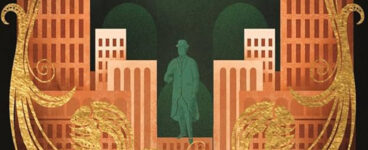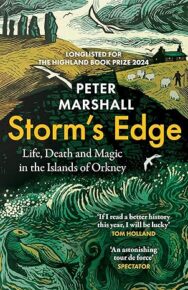‘And the way Marshall writes history, putting the spotlight on Orkney and its people and showing how their history is anything but peripheral, finally does them justice. ‘
David Robinson finds a lot to love in reading Peter Marshall’s history of the Orkney islands.
Storm’s Edge: Life, Death and Magic in the Islands of Orkney
By Peter Marshall
Published by William Collins
If you want a crash course in how difficult it is to generalise about the past, try reading Storm’s Edge, Peter Marshall’s erudite yet accessible history of the Orkney Islands (‘If I read a better history book this year, I shall be lucky’ – Tom Holland) which is just out in paperback.
Let’s say, for example, that you want to know when the islands changed ownership, religion, or language. Well, let’s forget the last one: no-one really knows when people stopped speaking Norn and started sounding Scottish because we didn’t have tape recorders back then. But the other two, ownership and religion: well, there are treaties, parliamentary bills, wills, diaries, memoirs, all manner of appointments and titles. And we already know what was happening in Scotland, Britain and Europe, so surely we can fit Orkney’s story into the bigger picture quite easily?
Ooops. Big mistake. That’s not how Marshall writes history. All too often, he points out, Orkney’s history is told like that – as an afterthought, not important enough in its own right, only occasionally surfacing as a ‘case study’ in a bigger story such as the Reformation or the rise of the British Empire. Politely, carefully, unpolemically, he suggests a better way: instead of looking at the history of the Orkney Islands through someone else’s prism, it should be valued for its own sake and, where possible, told from an Orcadian perspective.
When you do that, a number of things happen. We all (I presume) know about the impigneration of 1468 – you know, when ownership of the islands was handed by the king of Norway over as a sort of pawn ticket instead of a dowry for his daughter’s marriage to the king of Scotland. In hindsight it might look as though this is when Orkney becomes Scottish, but it’s not remotely as simple as that.
In 1468, for example, the bishopric of Orkney wasn’t answerable to anywhere in Scotland, as St Andrews only became an archbishopric four years later. Instead, the island’s clergy looked for religious supervision to Trondheim, which in medieval times had ten bishoprics under its wing: four in Norway, and – moving westwards – Orkney, the Faroes, Sodor (Isle of Man and and the Hebrides), two bishoprics in in Iceland and a short-lived one in Greenland. As a corrective to an Edinburgh- or London-centric version of the islands’ past, that fact is hard to beat.
As Marshall points out, the islands were in geopolitical play for a long while after 1468. All it took was for one polity to have a serious reverse (the Scots offered the islands to the Norwegians after Flodden), be short of cash (the Danes made a 1542 offer to England’s Henry VIII), be fighting a civil war (Britain’s Charles I suggested deals to the Danes in 1640 and 1643 and his son Charles II offered one with the Dutch in 1653 ) and a Chagos-style islands-for-cash proposal would be made. Even if nothing came of any of these plans, the political ties that bound the archipelago to mainland Scotland or Britain don’t look particularly strong.
Ties with Bergen, however, were. The largest city in Scandinavia had all the wood the Orkney merchants could possibly want to build ships and houses back home in exchange for their bere (barley), malt and oatmeal, and as late as the middle of the 17th century 56 Orkney-born merchants were registered as burgesses in the city, compared with 69 from the whole of the rest of Scotland. And trade didn’t just mean trade. It could herald heresy too. In those strange years when England was Protestant and Scotland Catholic, for example, those Orcadian merchants would visit many other countries where the Mass had already been abandoned, and purgatory abolished and statuary smashed. They were bound to bring some of those ideas back home.
And so they did, but again and to use the modern cliche, the Reformation in Orkney was a process, not an event. Unlike Professor Marshall, who has won the Wolfson history prize for his last book on the subject, I’ve always stayed well clear of Reformation history, so I’ll accept his assessment that in Scotland it began in 1559-60 but continued for years afterwards. The presbyterian variety took a long while to triumph in Orkney: so long that the islands had eight Protestant bishops before the abolition of the episcopacy in 1688.
Although religious change did come, it came with a peculiarly Orkney twist. If anything, that’s the point of Marshall’s history: when you study history from the ground up at a local level, you realise how rarely events fit into any kind of generalisation. In 1561, for example, when their bishop (appointed by the pope two years earlier) tried to introduce the new form of worship at Kirkwall’s St Magnus Cathedral, a Catholic mob tried to stop him – almost the exact opposite of what was happening at the time in Perth, St Andrews and Dundee, where Protestants were ransacking churches and demanding the overthrow of the old order. And although Kirkwall’s cathedral was subsequently ‘purged’ of what Knox called ‘monuments of superstition and idolatry’, somehow three small statues managed to survive. It is, as Marshall points out, ‘unlikely to be a coincidence …. that they are stately images of the three Norse ruler-saints, Magnus, Olaf and Rognvald’.
Just pause for a moment to think about that, because it’s another paradigm about how the past sometimes lives on despite the present. When Kirkwall cathedral’s shrines were destroyed, the bones of the two Orkney saints – Rognvald and Magnus – were preserved, hidden away in nearby pillars and discovered, in one case, in the mid-18th century and in the other, in 1919. The skull believed to be that of St Magnus belonged to a man who was killed by a vertical blow, which matches much of the story of his martyrdom in 1117 as told in the Orkneyinga Saga, in which he implored his killer on the island of Egilsay to strike a blow to the front of his head rather than merely behead him like a common criminal.
The new religion meant an attempt to put an end to other beliefs too: saints’ days were scrapped, but pilgrimages persisted despite repeated censure from the pulpit. Throughout much of the period under Marshall’s magnifying glass – basically from 1540-1814 – ‘the old ways’ persisted in various forms, and Marshall breaks new ground in his comprehensive study of Orkney witchcraft.
Between 1594 and 1708, at a time when witchcraft was a capital crime, 97 people were accused of witchcraft on Orkney – proportionately twice as many as in Scotland overall. Most of them (81) were women, often itinerant ‘charmers’ practising magic from the pre-Christian Scandinavian past, begging for food, drink and money and making veiled threats if this was denied them. Very little seems to have had anything to do with the devil himself; it was more a case of placating the ‘fairy folk’ who were thought to be notoriously capricious in the spells they placed on crops, farm animals and people. Indeed, as Marshall points out in his book’s opening sentence, one of his own ancestors was killed by a curse from a witch (on Sanday in 1624) who was then burned at the stake just outside Kirkwall.
Since 2019, there’s been a small memorial on the spot where those accused of witchcraft met their horrible deaths. Carved on a blue-grey sandstone slab is a circular image of sundial (to show the healing passage of time) with the words ‘They were cheust folk’ surrounding it.
Indeed they were. Just folk. Folk who might have said an angry word when robbed of a handful of oatmeal (that’s why Anie Tailzeour, the woman who cursed Marion Paulson, Marshall’s ancestor, ended up at the stake). Folk caught up in feuds between rival landowners. Folk who were blamed for drownings at sea because they said the wrong thing at the wrong time. Just folk. And the way Marshall writes history, putting the spotlight on Orkney and its people and showing how their history is anything but peripheral, finally does them justice.
Storm’s Edge: Life, Death and Magic in the Islands of Orkney by Peter Marshall is published by William Collins, priced £25.
ALSO IN THIS ISSUE

 Murray Hall by Milo Allan
Murray Hall by Milo Allan
‘Ah’d say Murray was one who lost a few lives along the way. So be it. Lives are made to be lost.’

 Walk Like a Girl by Claudia Esnouf
Walk Like a Girl by Claudia Esnouf
‘Suddenly there was a huge bang. The driver yelled. The car screeched to a stop. We all gasped, lurc …













